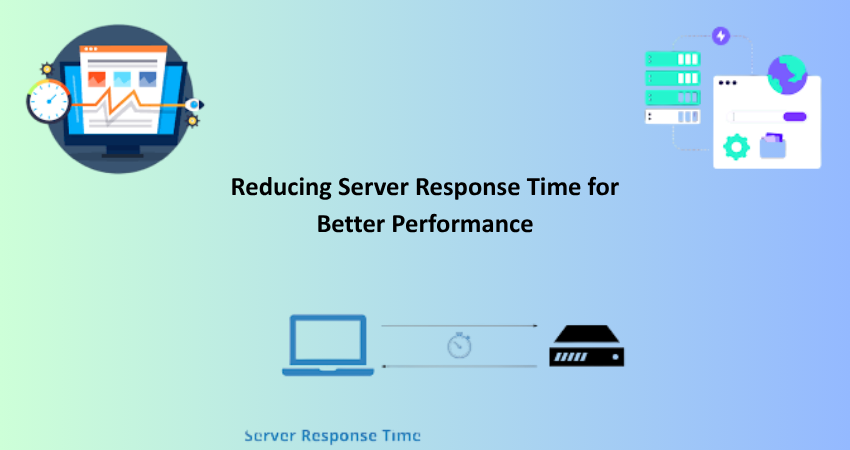
Introduction
Timing is everything in the digital world. Performance impacts User experience, SEO rankings, and conversion rates. Server response times are considered one major performance factor: the Time to First Byte (TTFB). This tells you how long it takes for a user’s browser to receive the first byte of data after the server gets a request. A slower server response will affect page loading time, thus annoying a user, and lead to a bounce. The time span for online attention is getting shorter, and competition is getting tighter; hence, reducing server response time has become an important goal.
Google maintains that keeping server response time below 200 milliseconds will enhance overall page performance. The optimization for this will involve backend types of optimization as well as configurations for servers and an apt selection of hosting infrastructure. This article presents in-depth strategies to reduce server response time and thus outlines what it really stands for and how improvements can be made to deliver a faster web experience for users.
Understanding Server Response Time and Its Impact
What is Server Response Time and Why It Matters
Server response time is defined as the time interval between the initiation of a request from the user by clicking a link or entering a URL and the delivery of the first byte of data from the server. This type of time lag has a direct influence on the speed at which a page starts to load; hence, it is a very basic metric of any kind of performance assessment for a website. Slow server response causes bottlenecks in the whole loading process irrespective of how well-optimized the rest of the site is. Users feel a delay even in fractions of a second. If the server response takes time, it directly translates into user dissatisfaction, especially with content-heavy and e-commerce sites where speed means sales.
In addition, server response time is one of the Core Web Vitals used by different search engines, including Google, to assess page ranking. Therefore, if TTFB remains consistently higher, it can penalize all aspects of a website in general in terms of SEO performance, which reduces chances of being featured at the top of search results. As a result, one comes to the conclusion that cutting down server response time is not only better user experience because it equates to a strong and pleasant visibility but also digital competitiveness. Consequently, this becomes something that concerns performance and thus each and every developer and site owner has to concern themselves with it very carefully and consider the performance issue very seriously.
The Technical Factors That Influence Server Response Time
The server responding time is influenced by several backend factors such as the processing power, memory usage, and software stack of the server. For instance, in shared hosting environments, response time is usually poorer because several sites will be competing for very little server resources. In contrast, dedicated or cloud-based hosting is usually characterized by far less variance in response times due to isolated resources and better scalability. The geographical location of the server also plays a decisive role with regard to latency; the closer the server to the user, the better the response time.
Server configuration and application logic play vital roles of their own in response time. Poorly written queries against the database, too many HTTP requests, and uncompressed assets can throw a wrench in server response. Besides that, there may be an old programming language or old framework that is being mostly unsupported and out of date; this can affect performance, too. And the other big factor will be the hardware-the ability of the backend code to run efficiently and the configuration of the server in managing the incoming requests will truly matter. Recognizing these factors and dealing with them could resolve the server response delay effectively.
Optimizing Server-Side Code and Database Queries

Streamlining Backend Code to Improve Efficiency
Optimize your backend code to bring server response time down to the minimum. Inefficient lines of code and even unnecessary ones introduce delays into the time frame used by the server to process user requests. So, clean, efficient, modular, and fast-running code is a requirement. This includes writing code to minimize loops, avoid redundant calculations, and delete unneeded functions and legacy code that are of no use. This will lead to streamlined application logic and drastically reduced response time.
Moreover, starting with caching in the application logic will reduce processing overhead. An illustration is that of caching computed values or frequently used data in memory instead of recalculating or querying them at each request: that saves a lot of time. Refactoring backend code to apply the best practices of software development such as the SOLID principles of object-oriented programming, will also improve maintainability and lead to performance gains.Profiling tools such as Xdebug or Blackfire provide insight into bottlenecks in code and thus help developers decide where improvement is desired.
Optimizing SQL Queries and Database Interactions
For dynamic sites heavily reliant on real-time data, database performance is significant to server response time. If the SQL queries are poorly written, the degradation of performance will be quite noticeable. These poorly written SQL queries involve lots of full table scans, nested queries, and missing indexes, thus severely slowing down performance. Optimization of these queries focuses on selecting the least amount of data by optimizing the queries as much as possible by avoiding the use of wildcard characters and employing other techniques, such as indexing, that speed up data retrieval. It is also useful to design structured and normalized database schemas to simplify the queries, allowing them to execute more efficiently during database interaction.
The essential thing to keep at the back of your mind is that connection pooling and caching of common queries reduce database latency. With Redis or Memcached, you can store the results of those queries in memory, thereby not hitting the database for the same request. New Relic or Query Monitor tracks slow queries with suggestions. Any way to optimize the application communication with the database will, in turn, reduce the waiting time in the server to fetch data, thus improving overall application response time.
Leveraging Hosting and Infrastructure Improvements
Choosing the Right Hosting Solution
The kind of hosting you’ve got determines the server response time. Shared hosting is the cheapest type of hosting, and most of the time, the lack of resources leads to resource contention, whereby different sites are using CPU and memory along with bandwidth. This sort of thing is extremely confounding when such performance fluctuates with the same time of the day. Now the step up would be VPS (Virtual Private Server), dedicated server, or cloud hosting managed solutions, such as AWS, Google Cloud, or DigitalOcean because they deliver better dedicated resources, entail stringent server configuration, hence improve response time.
Some hosts specialized in managed WordPress services like WP Engine or Kinsta provide environments built with optimal performance among others explored features such as auto-scaling, server-side caching, and CDN integration. These systems were made to host requests coming from dynamic content management systems, delivering swiftness in response times. Developers should weigh their individual project requirements to select a hosting solution that avails both scalability and good speed to support fast, reliable server responses.
Implementing Content Delivery Networks (CDNs)
CDNs are basically refrigerators for content serving from an international audience website so that server response time is minimized. CDNs cache copies of all assets from your site like images, stylesheets and scripts on different servers in many places worldwide. In response to a user’s request for content from the website, the CDN retrieves it from the nearest server node and, since the data has a much shorter distance to travel over networks, the response is received quicker. Site loading times are quicker, and your origin server gets reduced traffic handling load.
Cloudflare, Akamai, and Fastly are just three of the big popular CDN providers offering such automatic asset minification performance enhancements, intelligent caching rules, and DDoS prevention. From that, as you integrate your CDN with your website, static and dynamic content will be delivered faster during spikes in traffic in response to a user’s request. Real-time analytics and performance optimizers provided by most CDNs allow developers to have action reports on improvements made in optimized delivery. All said, a good CDN perfects the high-performance prescribed standards for responsive web structures.
Enhancing Server Configuration and Application Caching
Fine-Tuning Web Server Settings for Speed
Server tuning enhances performance and significantly decreases response times when considered on a wider scale. Apache, NGINX, and LiteSpeed are some of the popular web servers. Default settings, however, are concerned more with compatibility than speed, thereby making any custom configurations worthy of notice. With such a configuration, we can say it is the keep-alive. Here, the server maintains a connection with the client for transfer of several requests, thus eliminating costs for overhead. Compression modules, such as Gzip or Brotli, are also configured at the level of compression before transferring files, which enables speedier delivery.
In addition, cache control headers must be set properly so clients can reuse cached resources instead of requesting them over and over again. Developers should aim to reduce the number of redirects and simply remove unnecessary HTTP requests, as each one incurs a little bit of latency. This is where tools like GTmetrix and Pingdom come into play; by analyzing existing server configurations, they provide useful insight and recommendations. Through this proactive approach to server settings, the developers can eliminate delay and ensure timely responses.
Utilizing Server and Application-Level Caching
Caching is one of the most efficient methods to reduce server response time. Server-side caching stores responses so that they can be served quickly without recalculation or data refetching. Application-level caching, performed through tools such as Varnish Cache and various plugins in CMS platforms, can lessen the server load significantly by delivering cached HTML files, database query results, or even downstream elements on a page, thus drastically cutting down the time to generate and respond.
In-memory data stores such as Redis or Memcached allow for faster caching, putting the frequently accessed data into actual memory (RAM). This can be used to cache session data, database query results, and other types of data. Coupled with lazy loading and asynchronous processing, caching can improve the performance of even the more heavyweight applications. The point is to implement a well-balanced caching strategy that guarantees freshness while enhancing performance so that the user sees content to which he is entitled while keeping the server’s work in check.
Monitoring, Testing and Continuous Optimization

Tools for Measuring and Diagnosing Server Response Time
In order to really achieve server response time reduction, first understand and measure it. There are various tools of performing it. Those who do the analysis of performance are Google PageSpeed Insights, Lighthouse, and GTmetrix; they provide a full performance report with TTFB metrics in them. Things that need improvement are marked and taught on the ground on how they can be handled. Real User Monitoring (RUM) tools such as Pingdom or New Relic would give insight over time on how real users navigate your website on different devices and locations.
They enable a developer to pinpoint such bottlenecks such as slow database queries, underperforming third-party scripts, or poor server configurations. Load testing, for example, using Apache JMeter or Load Impact simulate traffic in order to gauge your server under intense pressure. Regular monitoring and testing allow a developer to keep his website fast and address performance regression as soon as possible before users have it.
Dependency on data organization for strategizing over performance in the long haul.
Best Practices for Ongoing Performance Maintenance
It is not a one time fix to reduce the server response time. Server response time reduction requires continuous efforts and adjustments over durations. Maintenance programs should be developed by the developers, which would provide a schedule for regular audits of server performance, updates to server applications, and optimization checks on backend codes. Security patches and performance updates must be deployed as soon as possible to avoid incurring any vulnerabilities and to ensure optimal performance levels. Similarly, keeping the frameworks, CMS platform, and plugins up to date helps maintain fast performance.
Furthermore, practicing continuous integration and deployment (CI/CD) can detect these performance issues prior to their reaching production. Whenever fresh code is pushed into the CI pipeline, process automation testing tools are employed to assure that it does not interfere with response time of server. By creating performance baselines with version-controlled configurations, teams keep a record of their efforts to improve server response time over a period. Maintenance of fast server response time thereby simply becomes an enduring quality commitment, demanding constant vigilance, monitoring, and flexibility.
Conclusion
Fundamental for any website to achieve its intended improvements in performance and SEO and thus user satisfaction is the reduction in server response times. Performance optimization can be achieved in multiple ways-from backend code and SQL query optimizations to leveraging the most modern infrastructure and well-thought-out server configurations for almost any layer of web stack. Developers knowledgeable about such techniques are good at creating responsive, high-performing, and scalable digital experiences to thrive in competitive environments.
Though optimized servers will cost both time and resources at the outset, the long-term rewards-faster load times, improved search visibility, and increased conversions-will make it worth your while. With constant testing and re-evaluation of your server strategies, you can keep your estimate of what a seamless user experience should be constantly valid along with what the end customers expect to see now.